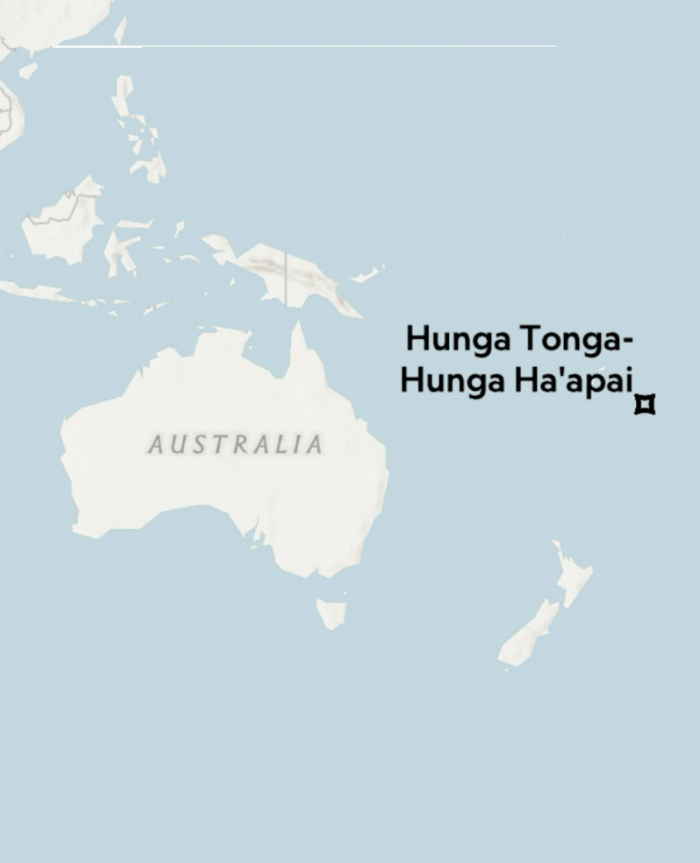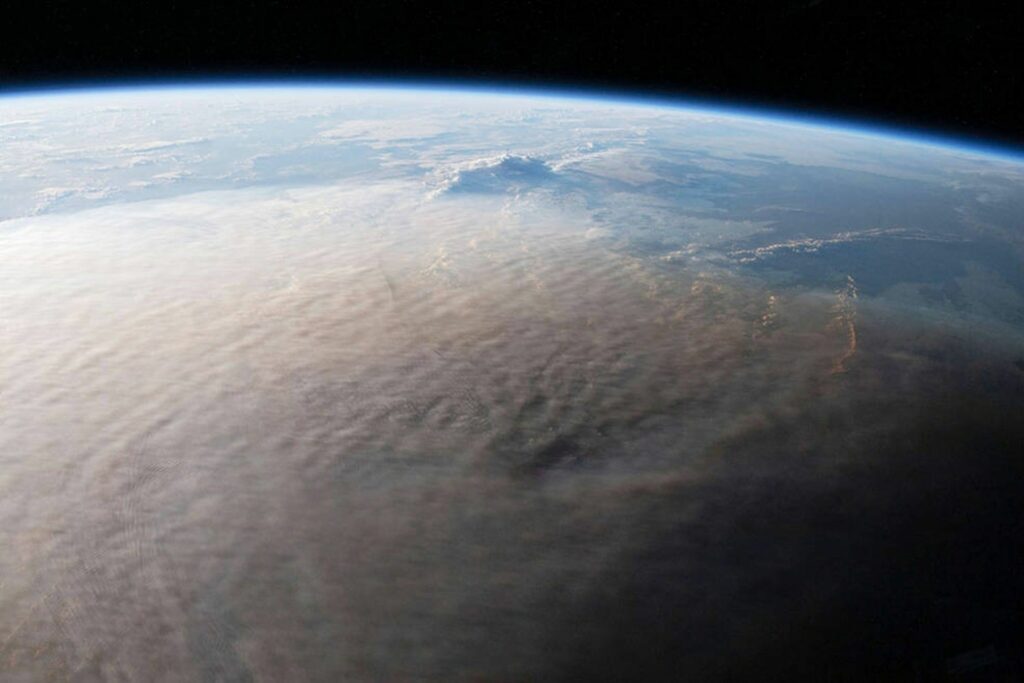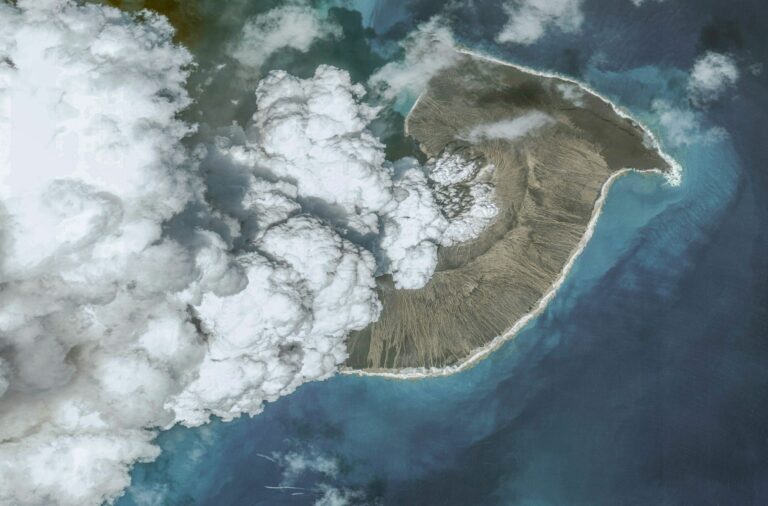The volcanic eruption in Tonga was of an even greater magnitude than previously understood.
Scientists are currently piecing together the aftermath of the devastating 2021 explosion, which resulted in the ejection of 2.3 cubic miles of rock. This cataclysmic event unleashed a colossal 35-mile-high plume and triggered a worldwide tsunami, prompting researchers to urgently investigate and comprehend the magnitude of the explosion. After extensive efforts, they are now finally assembling the fragments and gaining a comprehensive understanding of the incident.
Crimson shades spread across the early morning skies above the Kingdom of Tonga as Grace Frontin-Rollet caught sight of a pair of small rocky islands from the front of the RV Tangaroa. Although the scene was picturesque, a hint of sulfur in the air served as a reminder to the marine geologist and her team of scientists that they had endured a six-day journey over rough waters to witness this sight. Nestled on the ocean floor, within the vast expanse between the two land masses, lay the crater of a colossal volcano that had erupted just months prior in one of the most significant and peculiar explosions ever witnessed.

Frontin-Rollet, hailing from New Zealand’s National Institute for Water and Atmospheric Research (NIWA), reflects, “I don’t believe the magnitude of what had occurred truly struck us until we arrived at the site.”
In December 2021, the volcano, named Hunga Tonga-Hunga Ha’apai after the two islands perched on its rim, awakened in a series of outbursts that escalated into complete chaos on January 15, 2022. The eruption was so thunderous that its sound reverberated all the way to Alaska, a staggering 6,000 miles away. However, much of the events of that day remained shrouded in mystery until now. Scientists, including those aboard the RV Tangaroa, are finally piecing together the puzzle, and the resulting image is nothing short of mind-boggling.
As the team revealed today, recent surveys of the ocean floor indicate that the eruption excavated approximately 2.3 cubic miles of rock. If confirmed, this eruption would be the largest on record in the past century, surpassing even the 1991 eruption of Mount Pinatubo.
Additional recent analyses have unveiled an array of unprecedented measurements. The explosion forcefully propelled a column of scorching hot gas and ash to a staggering height of 35.4 miles, surpassing any previous observation. It injected an unparalleled 146 teragrams of vaporized water into the atmosphere, leading some to speculate that it may cause a slight, temporary climate warming. Furthermore, it triggered a tsunami that astounded scientists as it traversed the globe.
Kevin MacKay, a marine geologist at NIWA who was aboard the RV Tangaroa, describes it as an immense event. As we delve deeper into its study, the magnitude of this event continues to grow.
Comprehending the multitude of effects resulting from this explosive climax extends beyond mere scientific curiosity. Numerous similar submarine volcanoes lie hidden off the coastlines worldwide. Most of these volcanoes remain unmonitored, and there are even more yet to be discovered.
Taaniela Kula, Tonga’s Deputy Secretary for Natural Resources, emphasized the vulnerability of nations in the Pacific Ring of Fire to the forces of nature during a press conference in May. He states that the eruption serves as a reminder that there is always more to learn about the colossal forces of our home planet, Earth.
Window into the deep
The South Pacific Ocean is home to a chain of volcanoes that were formed as a result of an ancient tectonic battle between the Pacific and Indo-Australian plates. Among these volcanoes is the formidable Hunga Tonga-Hunga Ha’apai, which today is represented by two small islands that served as a signal to Fontin-Rollet and her team that they had reached their destination. As they gazed upon the islands, they couldn’t help but realize the immense size of the hidden geological beast that lay beneath the water, dwarfing their 230-foot ship.
The presence of water surrounding the volcano has posed a challenge for scientists in their quest to understand the events of the tumultuous eruption that occurred last January. When magma and water mix, it results in the formation of billowing steam and powerful eruptions. However, what exactly triggered the surprising chain of events at Hunga Tonga-Hunga Ha’apai remains a mystery. To uncover the answers, scientists had to venture closer and examine the volcano firsthand.

PHOTOGRAPH BY NASA
In April, the Tonga Eruption Seabed Mapping Project (TESMaP), a collaborative effort between NIWA and The Nippon Foundation, commenced with the arrival of the RV Tangaroa. This two-part survey was aimed at mapping the seafloor and conducting various analyses. Following this, in August, the uncrewed vessel Maxlimer, operated remotely by a team in the U.K., continued the expedition.
During the research, the team meticulously mapped an extensive area of approximately 8,500 square miles surrounding the volcano. They captured images, videos, and collected samples of volcanic rock and ash. The findings revealed a significant portion of the region to be devoid of life, covered in a hauntingly white layer of fine sediments. The investigation of rocky cores collected from these areas unveiled the cause of the devastation: a rapid and deadly pyroclastic flow, consisting of hot ash and volcanic debris, resulting from the collapse of the rising plume of ash and gas.
It is important to note that the dynamics of pyroclastic flows underwater remain speculative, as no firsthand observations have been made. One theory suggests that as the debris descends into the sea, the heat from the ash vaporizes the water, creating a gas layer that propels the material across the ocean floor.
The team discovered evidence of multiple instances of pyroclastic flows radiating from the caldera’s rim. These volcanic avalanches traveled over rises and into valleys, extending up to 50 miles beyond the team’s survey area, indicating the possibility of even further travel.
Furthermore, it is believed that the pyroclastic flows were responsible for severing both domestic and international communication lines for Tonga, which initially hindered recovery efforts. Modelling conducted by NIWA’s Emily Lane suggests that volcanic material entered a valley containing one of the cables, rebounding off the depression’s walls. This behavior could potentially explain how a broken fragment of the cable was dragged northward towards the peak.
The most recent study has also recorded that the explosion of the volcano caused a 2,300-foot excavation in the central crater. This finding supports the results obtained from a previous survey conducted in May by volcanologist Shane Cronin from the University of Auckland in New Zealand and a team from Tonga Geological Services. Richard Wysoczanski, a marine geologist with NIWA, remarks, “There is now a significant cavity in the ground where there was none before. It is truly remarkable.”
Approximately three quarters of the excavated and erupted rock seems to have fallen within a 12-mile radius of the volcano. The remaining material likely dispersed in the atmosphere as dust for several months, enhancing the vibrant colors of sunrises and sunsets, according to MacKay. This same phenomenon occurred after the eruption of Krakatoa in 1883 and possibly served as inspiration for the red skies depicted in Edvard Munch’s painting “The Scream.”
Although the eruption has subsided, the volcano has not completely returned to a dormant state. Currently, it is emitting hot water mixed with fragments of volcanic glass. Wysoczanski states, “It is not entirely inactive,” but he adds that the likelihood of another major eruption in the near future is low.
View from the sky
The volcanic eruption left scientists astonished as they discovered that the slopes of the volcano remained intact despite the powerful blast. According to MacKay, it appears that all the eruptive energy was directed straight upwards towards the sky. This peculiar phenomenon may provide an explanation for another remarkable aspect of the eruption: the height of the plume.
When the volcano erupted, a combination of gas and ash surged into the sky, which was captured by satellites orbiting the Earth. The question arose: how high did the plume actually reach? Simon Proud, an expert in satellite remote sensing at the UK’s National Centre for Earth Observation, was taken aback when he initially calculated the numbers. After double-checking his work, he confirmed the seemingly improbable result: the plume soared to a height of 35.4 miles, reaching the mesosphere, an atmospheric layer where most aircraft cannot fly and shooting stars illuminate the night sky.
Lead author of the paper on the plume height, Proud, expressed his astonishment, stating, “We’ve never witnessed anything ascend to such heights before. It was truly awe-inspiring.”
As the terrifying plume spread across the island nation, tsunami waves began crashing onto nearby shores, with some estimates suggesting swells exceeding 50 feet in height. To the surprise of scientists, the disturbance extended to oceans worldwide, causing sea levels to rise by a foot in the Mediterranean Sea on the opposite side of the globe.
A multitude of factors contributed to the occurrence of such an extraordinary tsunami. In close proximity to the volcano, the collapse of the caldera floor and pyroclastic flows agitated the turbulent movement of the sea. Additionally, the blast induced significant drops in air pressure, effectively “energizing the tsunami,” as explained by Lane, an expert in violent phenomena from NIWA.
A different process was occurring far away from the volcano. The massive plume of volcanic activity forcefully displaced the atmosphere, causing waves to ripple across the globe for a duration of six days. Quentin Brissaud, a geophysicist from the Norwegian Seismic Array and co-author of a paper detailing the atmospheric effects of the eruption, explains that the explosion was so immense that it caused oscillations in the atmosphere.
These ripples, as they traveled around the world, disrupted the surface of the ocean, resulting in a meteo-tsunami. The only other instance of this phenomenon being documented was during the 1883 eruption of Krakatau, which was one of the most devastating and powerful volcanic eruptions in recorded history.
However, numerous unanswered questions still surround Hunga Tonga-Hunga Ha’apai, including the exact cause of the volcano’s intense roar.
As Wysoczanski points out, “The scientific exploration is only just beginning.”
Do not forget to share your opinion with us to provide you with the best posts !




0 Comments